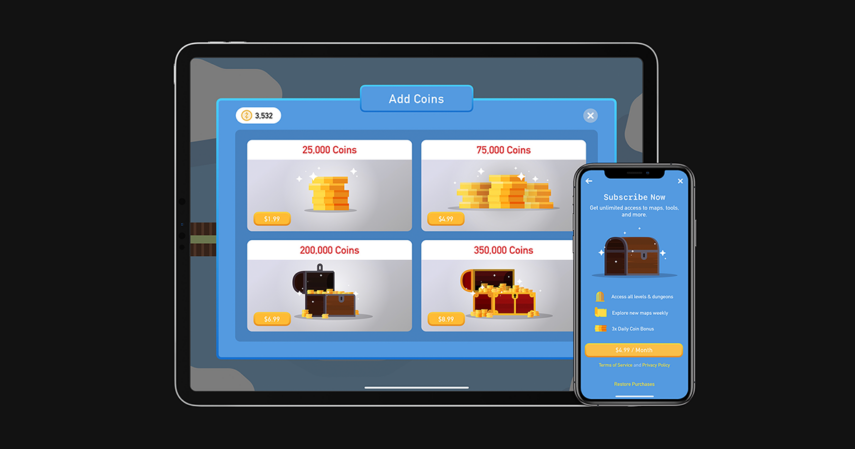Are you looking for ways to monetize your app? Are you struggling to turn a profit with the venture and in need of advice on what strategies can be employed? You’re not alone – many developers find themselves lost when it comes to creating sustainable revenue streams while developing apps. If this sounds like your situation, then have no fear: This guide is designed specifically to help mobile app developers learn all about monetization strategies, unlocking their potential for earning profits on their creations. We cover everything from basic advertising models, in-app purchases and subscriptions, and other cutting-edge options such as blockchain technology. By reading through our comprehensive discussion of mobile app monetization techniques, you’ll gain the knowledge necessary to make an informed decision about how best to capitalize on your valuable assets!
Introduction: Overview of Mobile App Monetization Strategies

Mobile app monetization has become an increasingly important part of the tech world, as developers need to make money off the apps they create in order to keep them alive and updated. There are a number of strategies that developers can use to monetize their apps, each with different levels of effectiveness and potential for return on investment.
The most popular mobile app monetization strategy is advertising – this involves displaying ads within the app itself or offering sponsored content within an app experience. This type of strategy is attractive because it requires minimal work from the developer and offers a steady stream of revenue, however, it can often lead to users feeling overwhelmed or annoyed with intrusive ads which may result in abandonment. Additionally, it’s worth noting that ad revenue typically comes with low payouts since there will always be a lot of competition in the space.
Another popular option for monetizing mobile apps is through in-app purchases. This allows users to pay for specific features or items within the app and can be structured in various ways such as one-time payments, subscription models, or virtual currencies. This strategy provides developers with more control over how much money they generate from their user base and also gives them the opportunity to offer exclusive paid features which help differentiate their product from others on the market. However, it can also be difficult to get users to buy into these types of transactions, and may require a lot of marketing effort to drive adoption rates.
Finally, another way developers can monetize their apps is through partnerships that allow them to integrate eCommerce capabilities into their platforms. These arrangements typically involve selling products directly within the app, either through traditional online stores or via dedicated marketplace platforms such as Amazon’s Appstore. The upside here is that retailers have access to huge customer bases which opens up opportunities for increased sales; however, it also requires additional overhead costs such as hosting fees plus any associated commission charges from third parties which could eat away at profit margins if not managed carefully.
Overall, there are many different options available when it comes to mobile app monetization strategies and what works best ultimately depends on individual needs and preferences. It’s important for developers to do their research in order to ensure they select an approach that suits both their business goals and end-user needs so that they can maximize revenues while keeping customers satisfied in the process!
Advertising Models: Exploring the Pros and Cons
Advertising models can be beneficial to businesses in a variety of ways. They can help advertise a product or service, draw attention to a brand, and create an emotional connection between the company and its target audience. On the other hand, working with models raises some issues that must be taken into account. For instance, hiring models can be quite expensive, as they require payment for their services. The right model also needs to be carefully chosen in order to ensure that it will adequately represent the brand and properly convey its message in a way that resonates with its target audience. Furthermore, there is also the risk of models not matching up with certain values or characteristics that the company wants to communicate. This could lead to the negative publicity that may damage the brand’s reputation in the long run.
When working with advertising models, it is important to consider both the advantages and disadvantages of doing so. However, if companies are able to find the right model who effectively conveys their message without alienating their target audience, then using models as part of an advertising campaign can prove to be extremely effective for businesses. With careful planning and consideration of all aspects involved in such a process, companies can make sure that working with advertising models leads only to succeed in their business endeavors.
In-App Purchases and Subscriptions: Examining the Most Popular Options

In-app purchases and subscriptions are becoming increasingly popular among mobile app developers as a way to monetize their products. These options give users the ability to purchase additional content or services within an existing app, or to pay a one-time fee for an entire year’s worth of access to the app.
In-app purchases are typically small, one-off transactions that allow users to buy individual pieces of digital content or features within an app. This could range from buying virtual currency in a game, unlocking new levels of play, purchasing extra content such as music, videos, or books, gaining access to exclusive features such as filters in a photo editing tool, or customizing an avatar in a messaging app. For developers, these purchases offer an efficient way to generate revenue without having to increase the cost of the base version of their apps.
Subscriptions offer another viable option for monetizing mobile apps. This approach requires users to sign up for a recurring payment plan in order to continue using the app. Developers can set different levels of subscriptions with varying benefits and pricing tiers. For instance, they may offer basic access at no cost but require users who want access to certain extra features or content to pay more on a regular basis – often monthly – through subscription fees. The advantage here is that it allows developers to generate stable and long-term revenue by offering customers ongoing value in exchange for their ongoing payments.
Cutting-Edge Techniques: Exploring Blockchain Technology for App Monetization
The topic of blockchain technology is one that has been gaining a lot of attention in recent years, and for good reason. In short, a blockchain is a digital ledger that records transactions across multiple computers—essentially an unstoppable, distributed chain of information. This technology has the potential to revolutionize the way we do business, as well as how we handle our finances and personal data. For app developers looking to monetize their apps, blockchain technology can provide an incredibly secure way to manage payments and transactions.
Using a decentralized system like blockchain means there’s no single point of failure—no one person or organization controls it. The transactions are validated by thousands of computers around the world rather than through any one central authority. This makes it nearly impossible for anyone to tamper with the system without detection—there must be a consensus among all the members in order for any changes to take place. As such, using blockchain technology can provide unparalleled security when it comes to handling financial information, personal data, and other sensitive materials.
Additionally, using a secure blockchain-based system also eliminates costly middlemen such as credit card companies or payment processors. By removing these costs from the equation, app developers would be able to keep more of their revenue in-house and quickly monetize their applications without worrying about additional fees or charges associated with traditional payment solutions. Blockchain also enables easier tracking of user engagement and allows developers to better understand their target audiences in order to optimize their monetization strategies accordingly.
Overall, blockchain technology provides an incredibly powerful tool for app monetization that any developer should seriously consider leveraging if they want their application to stand out from the crowd and maximize its potential earnings. With its unparalleled security measures along with its ability to eliminate costly middlemen fees, utilizing this cutting-edge tech could open up a whole new world of possibilities for any app creator looking to make money off their projects.
Conclusion: Why It’s Important to Create Sustainable Revenue Streams with Your Mobile App

Creating sustainable revenue streams with a mobile app is essential in order to ensure the long-term success of any business. There are several different ways to monetize an app, but all of them have one thing in common – they require an effective strategy and execution. A well-thought-out monetization plan can provide businesses with a steady stream of income over time, allowing them to focus their efforts on other areas such as product development and marketing.
One popular option for generating revenue from a mobile app is through in-app purchases. This involves offering customers virtual goods or services within the app for real money. For instance, users can purchase extra levels in a game or additional features such as filters for their photos. This is often seen in subscription-based apps where users pay a monthly fee for access to advanced features or exclusive content. Another way to monetize your app is through advertisements which appear within the interface of the application and generate revenue from each click or view.
No matter which approach you choose, it’s important to remember that creating sustainable revenue streams with your mobile app requires consistent effort and upkeep over time. You need to constantly analyze user data and adjust your strategies accordingly while also staying up-to-date on industry trends and customer needs. Additionally, if you’re using ads to monetize your app, it’s critical that you optimize the placement of these advertisements so that they don’t interfere with user experience or cause too much disruption. At the end of the day, successful monetization hinges on creating an engaging user experience and providing value that customers are willing to pay for – so make sure you don’t lose sight of that!
When building a successful mobile app, it’s essential to create sustainable revenue streams in order to ensure longevity. Keeping up with the ever-evolving landscape of technology can be daunting, but there are options that are worth exploring from advertising models and in-app purchases to cutting-edge solutions such as blockchain technology for app monetization. Each option has pros and cons that need to be carefully considered, but by relying on data and an in-depth understanding of user behavior, developers at Koombea can select the solution that will best fit their needs. To succeed in the long term, it’s important to focus on customer retention over short-term gains because a monetization strategy should be linked closely to the customer experience. Finally, don’t forget, successful app monetization isn’t all about making money: It’s also about creating value for users. In addition to leveraging these strategies outlined here, think outside the box and come up with brief ways to serve your customers better. Read more here.
Related Posts:
- Smartworks launched a new mobile app for Businesses-…
- 4 Mobile Betting Strategies That Actually Don't Work
- Unlock Online Success: Why and Who Needs a Website?
- Unlock the Perfect Grill Experience with a Traeger…
- 8 Benefits of Outsourcing Mobile Form App Development
- 10 Common Web Designing Errors That Drive Away…







